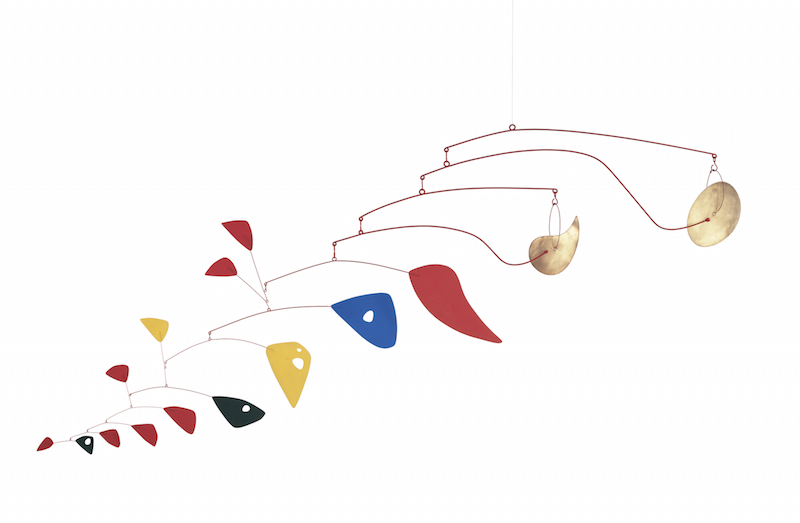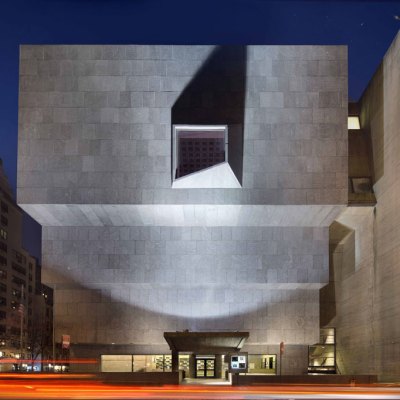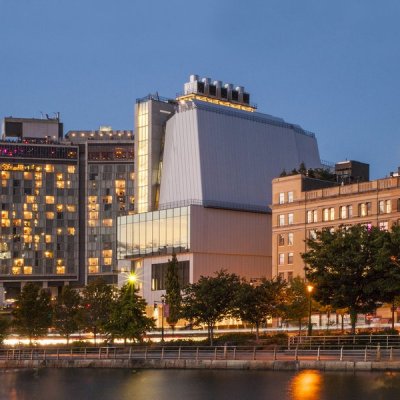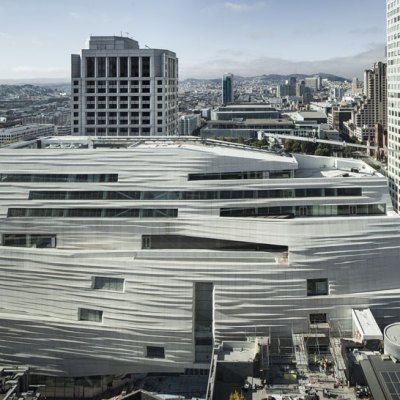On 14 May the San Francisco Museum of Modern Art (SFMOMA) reopens after a three-year-long expansion and transformation. Ingeniously squeezing every inch out of an only slightly expanded urban footprint, Norwegian architectural firm Snøhetta has created seven floors of airy galleries. For the reopening, the museum will have not just more of its permanent collection on view; it will also inaugurate its Pritzker Center for Photography, show off some 650 of the 3,000 or so new gifts amassed during the closure, and introduce about 260 works from the Fisher Collection, whose new century-long loan scheme offers an innovative way for collectors to place their art in the public domain.
Rendering showing the new SFMOMA extension designed by Snøhetta. © Snøhetta and MIR

In many ways SFMOMA’s story embodies the West-Coast optimism and entrepreneurship that began with the Californian gold rush of 1848–55 and the completion of the First Transcontinental Railroad – qualities that have made it what it is today: a world-class museum at the hub of the city’s downtown regeneration. With strengths in North American art – especially Pop, minimalism, and post-minimalism – and in post-war German art and British sculpture, as well as its formidable collection of American and Japanese photography, director Neal Benezra can rightly claim: ‘We feel we are now as strong as any public collection of modern art in the country.’
Founded as the San Francisco Museum of Art (without the ‘Modern’) by Grace McCann Morley in 1935, its first significant gift was from the insurance broker Albert M. Bender. It included Frida Kahlo’s own wedding portrait with Diego Rivera (1931), inscribed to Bender, and a number of photographs, which soon had their own curator – the museum was early in recognising photography as a fine art. Today Sandra Phillips, the senior curator of photography, calls her department ‘a museum within a museum. Photography has always been the largest part of the collection.’
In 1936, the museum gave Henri Matisse his first solo show on the West Coast. Most pieces were local loans and many were gifts, including Femme au chapeau (1905). Gary Garrels, senior curator for painting and sculpture, calls it ‘the cornerstone of our modern collection’ and has hung it back where it was, in a spot which is now visible from a lobby that joins the old and new buildings. In 1975 the museum received a gift of 28 paintings from Clyfford Still and added ‘Modern’ to its name. SFMOMA’s tradition of collecting contemporary artists in-depth was established. ‘There was never a goal to be encyclopaedic in any way,’ Garrels says. ‘Even now we have no major Bridget Riley.’
Femme au Chapeau (1905), Henri Matisse. Photo: Ben Blackwell; © Succession H. Matisse

All this time, the museum was huddled on one, then two floors of the War Memorial Veterans Building. Phillips, who came to the museum in 1987, remembers photography shows hung in corridors. In 1995, the museum moved into the then-edgy downtown area, into a purpose-built home designed by the Swiss architect Mario Botta. It stood alone, fortress-like amid car lots and abandoned offices and warehouses.
In the same year it was one of the first US museums to launch a website. It also greatly enriched its collection to include René Magritte’s Les valeurs personnelles (1952), given by the San Francisco philanthropist Phyllis Wattis (dubbed ‘California’s Brooke Astor’), and 14 works by Robert Rauschenberg, which were partly given by the artist and partly funded by Wattis.
When Neal Benezra arrived as director in 2002, the Bay Area collectors Harry and Mary Anderson had just given seven major Frank Stellas, including one of his ‘Black Paintings’, Zambezi (1959), which prompted the artist himself to donate one of his works, in honour of the Andersons. The collection was growing through its own momentum, but few could see it. Benezra, who grew up in San Francisco, had been working in Chicago and Washington for 20 years. ‘I would read about the new acquisitions but when I returned home they were never on display. It was 70 per cent exhibitions, 30 per cent collection,’ he says. ‘Outside of New York, San Francisco has the most and finest private collectors of contemporary art in the US,’ he states. ‘I knew that we had to make space for what we had and for those collections.’
Looking at how other US museums had nurtured collectors who then, with luck, donated their art, Benezra saw that museums were no longer offering what collectors were seeking. The result was that collectors did not donate so much, and museums lost out. He also observed that collector-museums tended to draw visitors for one visit, but no more. Doris and Donald Fisher, whose idea to make their own collector-museum on San Francisco’s Presidio had floundered in 2009, were also interested in a new solution so that their art could ‘stay together and be shown in public’, as their son Bob Fisher explains. ‘Neal was talking about expanding the museum. My parents trusted Neal. Gary [Garrel]’s return to SFMOMA [his earlier stint was 1993–2000] was important in cementing the relationship. He was in close sync with how my father collected.’ Benezra struck a new public-private partnership deal for the Fisher Collection to be displayed in the museum for 100 years in decade-long cycles: every 10 years a major exhibition of only their art; then nine years of it being integrated it with the museum’s own collection. Benezra hopes this ingenious West Coast scheme will set a precedent for how collectors can work with established museums.
The Fisher Collection is a perfect fit for SFMOMA. In the four decades after they founded the clothing company Gap in 1969, the Fishers, like the museum, focused on acquiring artists in-depth. ‘It didn’t take long to outgrow the home,’ says Bob Fisher, who is now chairman of Gap. ‘Having office spaces with 15-foot-high ceilings allowed them to buy Anselm Kiefer works. So my father’s imagination was the limit of what he could collect. There weren’t many artists to collect then. The art world was so different.’ The Fishers acquired works by Andy Warhol, Alexander Calder, Roy Lichtenstein, Ellsworth Kelly, Gerhard Richter, Anselm Kiefer, Chuck Close, Claes Oldenburg, and Coosje van Bruggen. Doris Fisher developed lasting relationships with some of the artists. Bob Fisher says: ‘My mom and Ellsworth had a very close relationship; they’d talk on the phone. She was also close with Richard Serra, Chuck Close.’
Cité (1951), Ellsworth Kelly. © Ellsworth Kelly; photo: Ben Blackwell

The museum’s first Fisher Collection hang of 260 works by about 70 post-war and contemporary artists fills three floors. It has not been an easy job for Garrels. Four galleries devoted to Ellsworth Kelly span the artist’s whole career; Agnes Martin’s refined, ethereal works are in an octagonal room with a central sofa because ‘they need time’; a Frank Stella print series runs along a wall that breaks open to give views over the city. ‘Soon after they started Gap, the Fishers started buying whole series of prints to see an artist’s development. So, you could see where their collecting was going,’ Garrels says. As for the Richter room, it took Garrels a month before he got it right. ‘You should walk in and get goosebumps,’ he explains. ‘It just wasn’t happening. I woke up one morning with an idea.’ He removed one painting and changed the position of another two. ‘And it works. Little adjustments can make a big impact, the difference between being perfectly fine and being magical.’
The museum’s choice of architect for its expansion was, again, innovative. Snøhetta – whose buildings range from the Bibliotheca Alexandrina in Egypt to the National September 11 Memorial Museum Pavilion in New York – had never designed a museum before. ‘We travelled with them to see what museums we liked and what we didn’t,’ Benezra says. What they liked included the Beyeler Foundation in Basel: ‘It has beautiful intimate spaces, so you look at the pictures in a different way, no question about it,’ he adds. The architects have prioritised the making of such spaces, together with drawing in the natural east light. They also thought hard about the visitor experience, creating galleries of different sizes and ceiling heights, and spaces to pause in.
View of SFMOMA from Yerba Buena Gardens. photo: © Henrik Kam, courtesy SFMOMA

Craig Dykers, a founding partner of Snøhetta, led the team of architects; Jon McNeal was the senior architect in their San Francisco office. Turning the long, narrow site to their advantage, they presented the necessarily tall and broad exterior to its advantage by casing it with a curtain wall of rippling horizontal bands, which reflect the light and stand out amid the new office towers. They made a second entrance: a glass-walled lobby with a spiralling Richard Serra sculpture, where amphitheatre-style seats invite the curious in from Yerba Buena Gardens, the area’s new public park. In the Botta building lobby, they unblocked the view of a distinctive but partially obscured ocular window, so light now floods in; and, with what McNeal calls ‘tremendous structural gymnastics’, they opened the Botta exterior wall to connect with the extension. There, visitors can opt to move from floor to floor using elegant stairways that remind them of hilly San Francisco’s city steps and, as McNeal puts it, ‘provide the physical reset of using their lungs, getting the blood flowing’. Terraces on most floors are backed with a lush vertical garden.
A space that incorporates many of these ideas is the permanent Calder gallery. Filled with low-hanging mobiles, Garrels explains that ‘it has intentionally low ceilings, as Calder wanted, so the mobiles are level with you and you feel a physical immersion’. A big red Calder sculpture stands on the garden-backed terrace visible through the glass wall.
Double Gong (1953), Alexander Calder. © Calder Foundation, New York / Artists Rights Society (ARS), New York

The rest of this floor is devoted to the new Pritzker Center for Photography: Phillips believes these galleries offer the most space in any US museum for the permanent display of photography. One suite of galleries displays works from the almost 18,000-piece collection; the other has temporary shows. This summer’s selections include Ansel Adams’s Surf Sequence (1940), a recent local gift to fill a lacuna in the extensive Adams holdings. In addition, an educational lounge with a coffee bar enables visitors to find out more about the photography collection. This floor also holds the black and white photography storage (colour photographs are kept in a basement fridge). And, to make the collection truly accessible, visitors can request a curator to bring stored works to a dedicated study room.
The museum turned its three-year closure to positive use. Benezra, assisted by his trustees, implemented a carefully planned Campaign for Art with two aims: to strengthen the collection and to fill gaps. As Bob Fisher says: ‘My parents’ gift was the catalyst. It blended well with the museum’s collection but left opportunities to complement the artists they collected. A new Richter line painting is a promised gift, as my parents stopped buying Richter in 2008.’ Three trustees each gave a work by Joseph Beuys, a key post-war German artist unrepresented in the museum’s collection.
Meanwhile, the SFMOMA On the Go project sent parts of the collection on tour around the Bay Area museums. The first show went around the corner to the Contemporary Jewish Museum, which opened in 2008 in an old electricity and gas sub-station transformed by Daniel Libeskind. Its director Lori Starr thinks SFMOMA’s reopening will be just the start: ‘Now we look forward to even more foot traffic,’ she says, referring to the longterm effect of SFMOMA’s trailblazing arrival in 1995. On weekdays, the area thrums with crowds taking a break from attending conferences at the Moscone Convention Center housed beneath the Yerba Buena public park, while office workers need respite from the gleaming new towers occupied by tech and investment companies. ‘They are known as the “local pop” and we hold lunchtime gallery chats for them,’ Starr says. This district, known as SoMa (South of Market Street), already has institutions dedicated to California’s history, cartoons, and the African diaspora, and the Mexican Museum is moving here soon.
Without question, San Francisco’s art scene is buzzing. High-end commercial galleries Gagosian and John Berggruen have just arrived near the museum, and innovative art spaces are a short ride away. At Pier 24, investment manager Andrew Pilara and his wife Mary, who collect photography, leased the magnificent space from the Port of San Francisco and six years ago opened the renovated building to exhibit works from their own and other collections. Down in the Mission district, artist David Ireland’s house at 500 Capp Street opened this January as the city’s first ‘house museum’, the achievement of Phyllis Wattis’s granddaughter Carlie Wilmans. The city’s BART train line crosses the Bay to stop at the door of Berkeley Art Museum and Pacific Film Archive, known at BAMPFA, another January opening. Here, historic and contemporary art meet in Diller Scofidio + Renfro’s playful refit of an abandoned printing works. And south of the city, where many collectors live, Pace has opened a gallery at Menlo Park, not far from Stanford University’s newly-completed McMurtry building housing its history of art department, which is right beside the Cantor Museum and the Anderson Collection.
Pleasures and Terrors of Levitation (1954), Aaron Siskind. © Aaron Siskind Foundation

The city’s long-established museums are booming, too. The Fine Arts Museums of San Francisco, comprising the Legion of Honor and the de Young Museum, have just netted Max Hollein, the widely respected director of the Städel Museum in Frankfurt. At the Asian Art Museum – the largest stand-alone museum in the US devoted exclusively to the arts of Asia – an expansion is under way. Its director Jay Xu defines SFMOMA’s new importance as ‘a contribution to art not only in San Francisco but along the whole West Coast. It was always important; now it is substantial. San Francisco is a global city with a strong regional focus.’
Yet, for all the buzz, there is unease. Exorbitant property and living costs caused by what is dubbed ‘the Google factor’ – the immense wealth of large numbers of Bay Area residents in the tech business who now want to live in the city – have driven out San Francisco’s artist community and much of its middle class. At first it was across the Bay to Oakland; now gentrification there is forcing them to move on. There is also anxiety that the young tech millionaires (and billionaires) might not develop into the next generation of art connoisseurs and supporters. However, local optimism and a drive to find solutions are already evident. Museums are targeting children and students with free entry and extensive programming, not only to offer democratic access to all but also – and this is said frankly – to nurture them as future supporters. Individuals are taking action: on 18 March this year, Minnesota Street Project, the brainchild of the entrepreneurs and collectors Deborah and Andy Rappaport, opened in the relatively isolated Dogpatch district of the city. The scheme uses profits from art storage in one building to fund affordable gallery space and artists’ studios in the others. The gallery spaces are full and include six established downtown galleries who have relocated here. During its first three days it had more than 6,000 visitors.
SFMOMA hopes to attract similar numbers on its opening weekend, when the whole of the resurrected SoMa district will be ‘en fête’. As Fisher says, ‘The West has always been the optimistic side of America, with endless possibilities. Now, with Silicon Valley, innovation and creativity are held in high regard here. And in San Francisco, if there’s one thing that embodies this, it is this museum, it’s on the walls.’
SFMOMA reopens on 14 May. Visit here for more details.
From the May issue of Apollo: preview and subscribe here.


